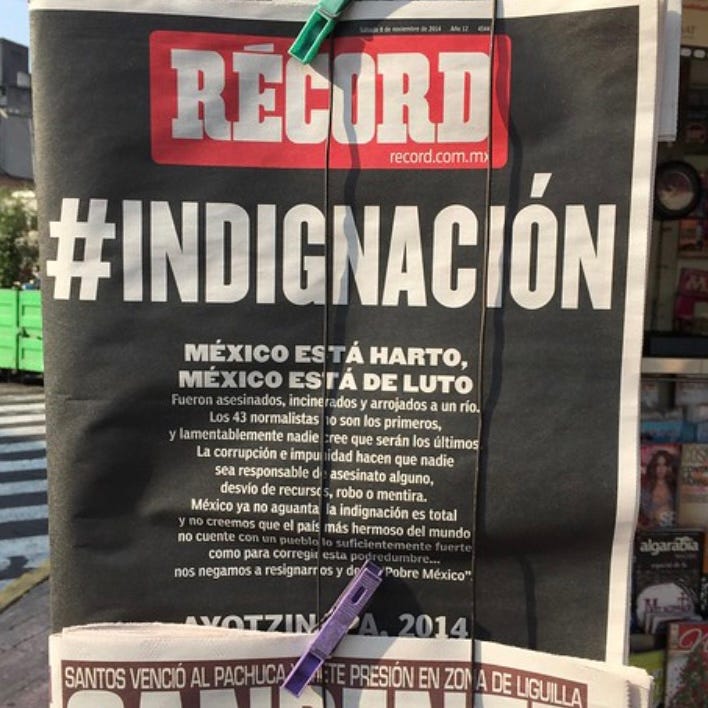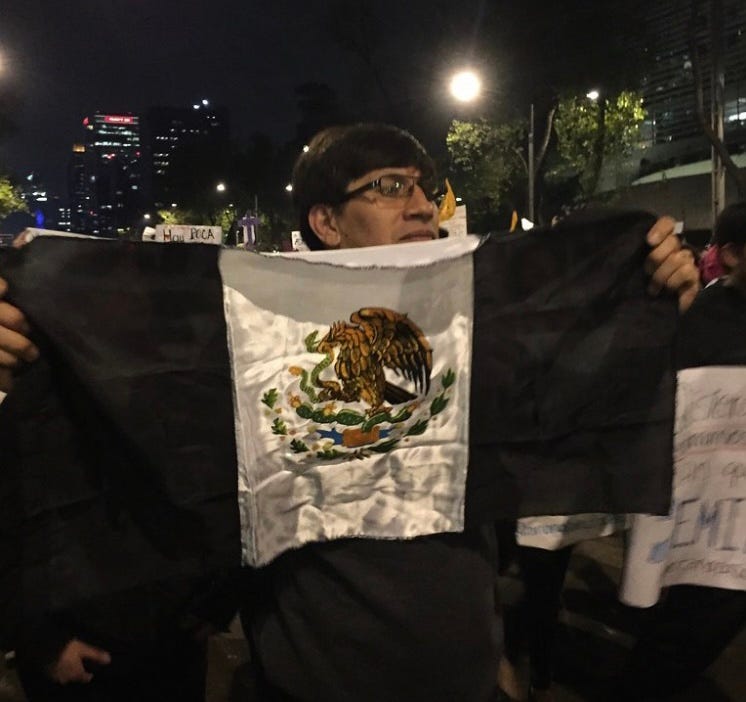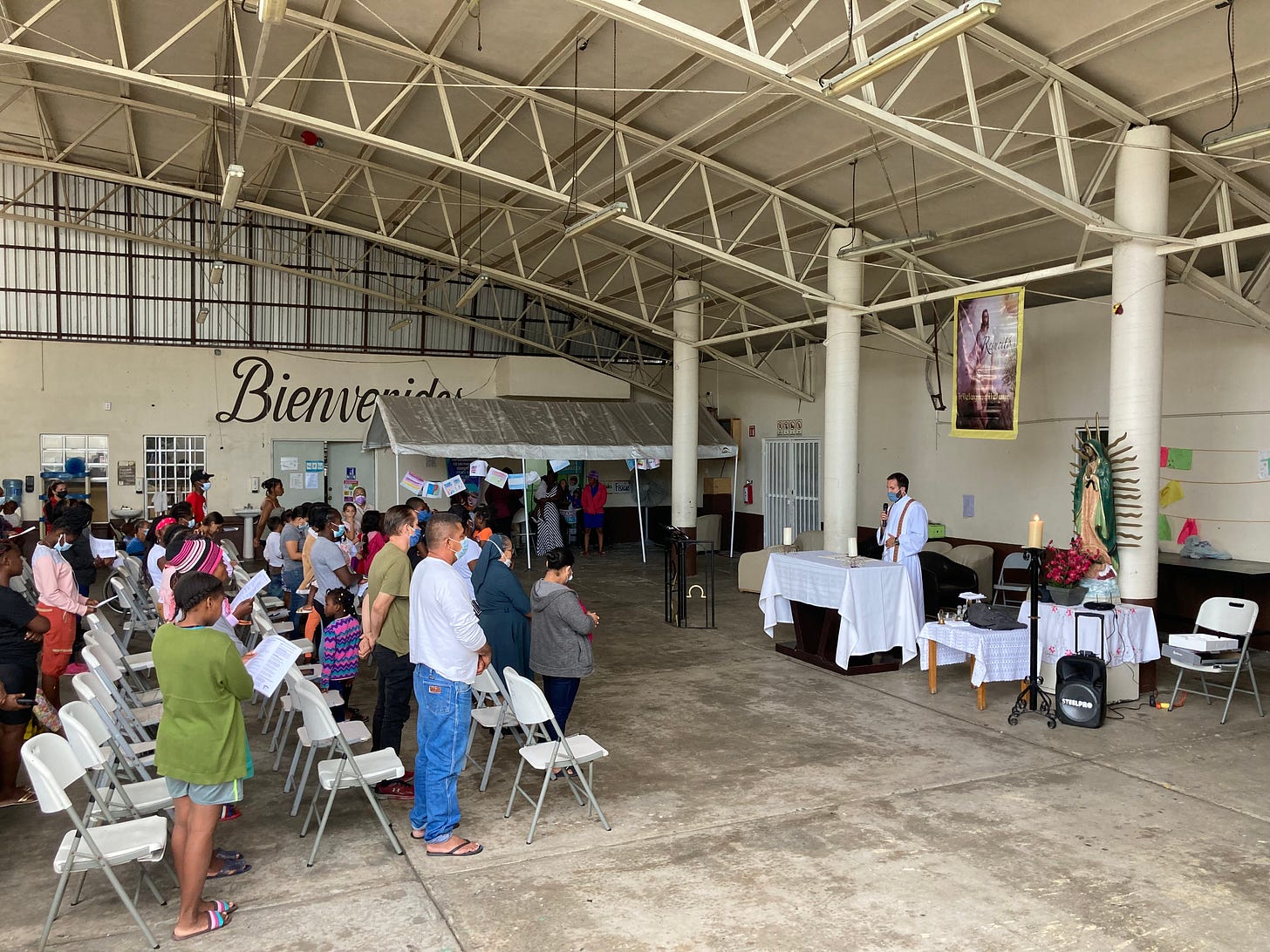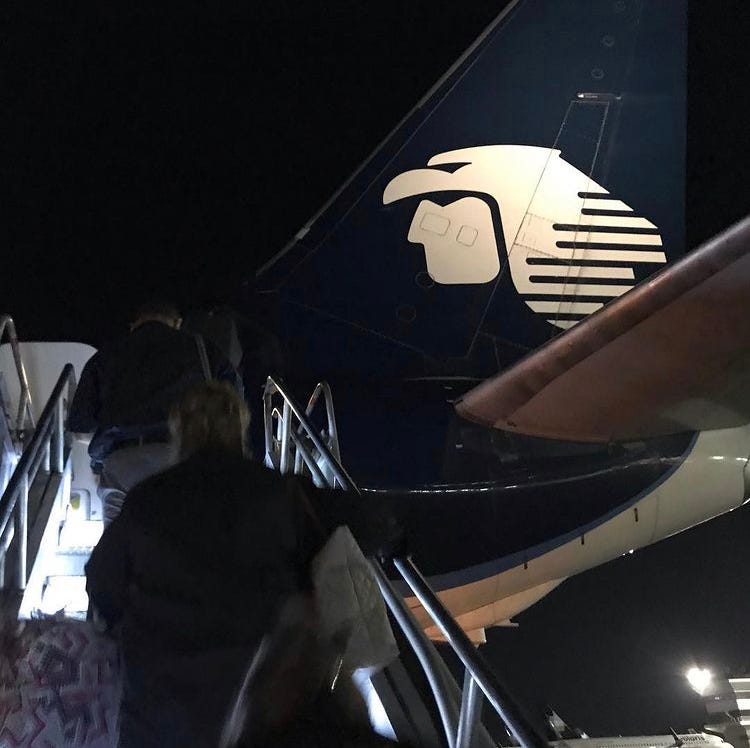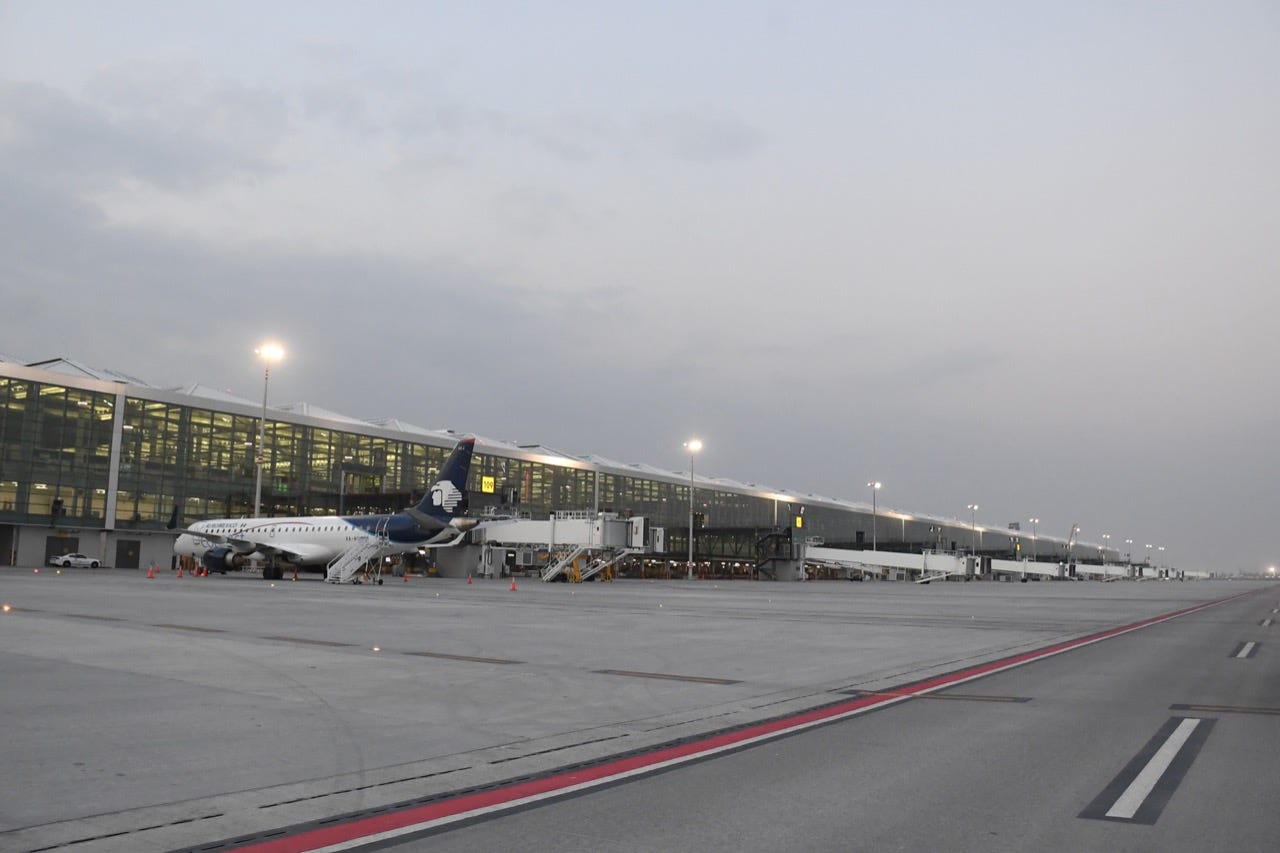Truth commission calls disappearance of 43 students a 'state-sponsored crime'
The 2014 disappearance of 43 teacher trainees at the hands of cops and criminals outraged Mexico. But observers say a new report into the crime oddly resembles the discredited document it replaces
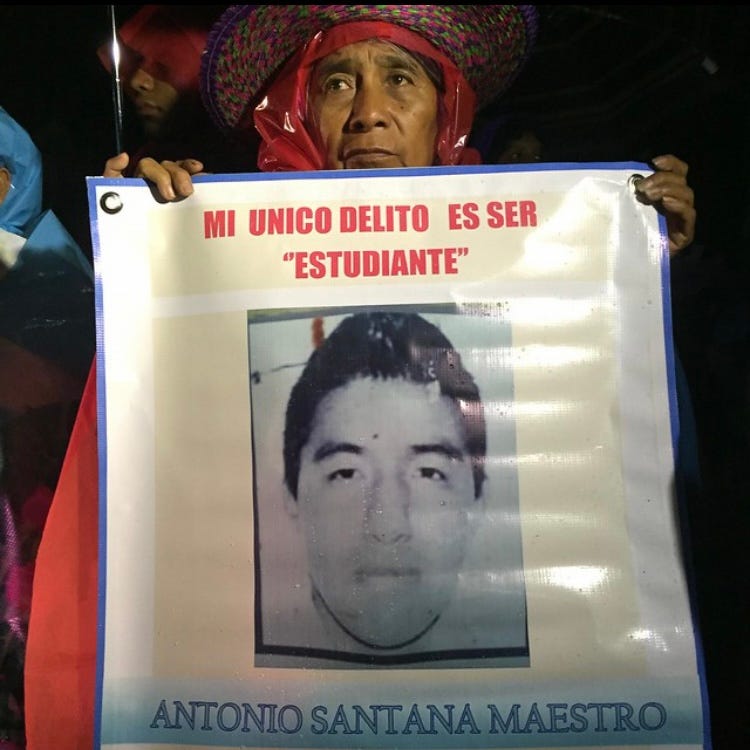
An inquiry has called the 2014 disappearance of 43 students at the hands of cops and criminals a “state-sponsored crime,” involving officials at all levels of government, including the military.
It also consigned a previously discredited hypothesis christened, “The historic truth,” to the dustbin of history as a politically expedient narrative – largely obtained through torture for closing an explosive case.
Former attorney general Jesús Murillo Karam – who coined the official investigation, “The historic truth” – was arrested Friday and held pending trial on accusations of torture, official misconduct and forced disappearance. Prosecutors also obtained arrest warrants for more than 80 individuals, including soldiers, police officers, public officials and gang members. The report said:
“At all times did federal, state and municipal authorities know the movements of the students, from their departing (their school) until their disappearance, and their actions, omissions and participation permitted the disappearance and execution of the students, as well as the murders of six other persons.”
The report rocked Mexico as the case of the missing 43 students has haunted the country for nearly eight years – ranking as one of the most notorious crimes in recent memory and a rude reminder of the rampant collusion between cops, criminals and politicians in a country with near perfect impunity.
The students’ disappearance captured international attention and prompted mass protests across Mexico, pulling all sectors of society into the streets. As Antonio Orduño wrote in El País:
“Los 43: the symbol of a country in the hands of criminals.”
It also permanently hampered then-president Enrique Peña Nieto, whose popularity plummeted with the inept response – even as he attempted to portray the students’ case as a regional crime and tried turning the page with a clumsy speech insisting Mexicans were “overcoming” the crisis.
President Andrés Manuel López Obrador (AMLO) has supported a continued investigation into the attack on the students – known as normalistas – and regularly held meetings with their parents to update them on advances in the case.
“We cannot hide a crime of any nature, especially such an infamous case with all its political implications,” AMLO said.
What happened on Sept. 26, 2014?
The government inquiry drew on more than 40,000 documents, along with wire taps, text messages and videos. Soldiers also turned over evidence – something long thwarted by then-defence secretary Gen. Salvador Cienfuegos.
It said the military had an informant imbedded with the students, who were headed to Mexico City for a protest and commandeered buses to get there. (The students’ commandeering of buses was common practice.) The report questioned why the military did not activate protocols to search for the informant, who was presumably killed with the rest of the students.
On the night of Sept. 26, 2014, the students commandeered four buses in the city of Iguala, about three hours south of Mexico City in Guerrero state, Mexico’s heroin-producing heartland. Police and gunmen forced the students off the buses and disappeared them.
Alejandro Encinas, the human rights secretary who presented the report, said, “There is no evidence they are still alive.” The remains of only three students have ever been identified.
“The historic truth” posited the students were taken to a garbage dump in the town of Cocula, where they were killed with their bodies burned in a funeral pyre and the ashes tossed in a river. Forensic experts rejected that claim and provided weather records showing rain on the night in question.
It was also alleged the head of the investigation, Tomás Zerón, likely planted evidence at the garbage dump and tortured suspects. Zerón, who is fugitive in Israel, did not cooperate with the investigation. Mexico has asked for Zerón’s extradition, but Israel has demurred. The New York Times reported in 2021 that Israel has no extradition treaty with Mexico and hasn’t acted quickly because of Mexico’s votes in the UN for investigations into allegations of Israeli war crimes against Palestinians.
New report or rehash of ‘the historic truth’?
The government inquiry has stoked disquiet since its release Aug. 18 with some in the chattering classes commenting that the report seems awfully similar to “the historic truth.” Others have questioned the case against Murillo Karam, asking how far up the chain of command the investigation will go and if it will actually pursue Cinfuegos – who was arrested in the United States in 2019, but returned to Mexico after the AMLO administration petitioned for his release – or even Peña Nieto, who has been living in Spain.

The report recognized military involvement in the case and didn’t discard it having to do with the movement of illicit merchandise – long a suspicion. A past report in the disappearances from outside experts from the Inter-American Commission on Human Rights – who were harassed out of the country by the Peña Nieto – spoke of a fifth bus, which may have been carrying heroin between Iguala and Chicago, and was accidentally commandeered. The new report said:
“It was established that the night of the disappearance, federal, state and municipal forces placed (at least) 16 checkpoints to cover all the entrances and exits of (Iguala). That bus was not stopped at any of those checkpoints so it is presumed that its contents, it is unknown what it was, money or drugs, was recovered.”
But along with presenting its finding, the new report took pains to point out what it considered the shortcomings in “the historic truth,” saying at one point:
“In the Ayotzinapa case investigation, they generated a narrative of convenience based on declarations obtained through torturing those allegedly responsible for the students’ disappearance, where the victims – the students – were re-victimized and stigmatized.”
It continued:
“The ‘historic truth’ was full of institutional actions and communications strategies, what had the goal of closing the investigation and providing a resolution.”
But the tone and the contents led some commentators to conclude the report was – like “the historic truth” – a document detouring into politics and not representing a rupture with what came before it. Writing in Reforma, columnist Roberto Zamarripa noted:
“The conclusion is essentially the same as Jesús Murillo Karam’s team arrived at: the normalistas were killed by a the Guerreros Unidos group in retaliation and /or (out of) fear the normalistas worked for Los Rojos, a rival group. The difference is that soldiers, public officials and police concealed the crime."
“The redaction of the report is political. The report concludes that the murder of the 43 [students] was a state crime, where narcotics traffickers and ‘agents from various institutions of the Mexican state acted together.’”
MEXICO STEPS UP IMMIGRATION ENFORCEMENT, THOUGH AMLO WON’T SAY IT
AMLO publicly welcomed the U.S. Supreme Court decision, which allowed the Biden administration to wind down the Remain in Mexico program, saying Wednesday:
“Now that the U.S. Supreme Court has made that decision, we see it as good. We are always going to, under any circumstance, care for migrants and treat them well.”
The statement came as a surprise: Mexico never publicly objected to the Remain in Mexico program (also known as Migrant Protection Protocols or MPP), which largely operated out of sight and out of mind for the federal government. The MPP participants in Mexico reported suffering crimes such as kidnaps and extortion after being dumped in dangerous Mexican border towns, while advocates for migrants say the federal government largely failed to come through with promised social services such as healthcare and education or job opportunities.
Neither AMLO nor anyone in his administration visited the massive Matamoros MPP camp, which swelled to more than 3,000 residents living in squalid conditions – though many U.S. activists and some political figures did, including Jill Biden. AMLO again mentioned that Mexico avoided becoming a “safe-third country” through MPP, though immigration advocates say the scheme operated as such.
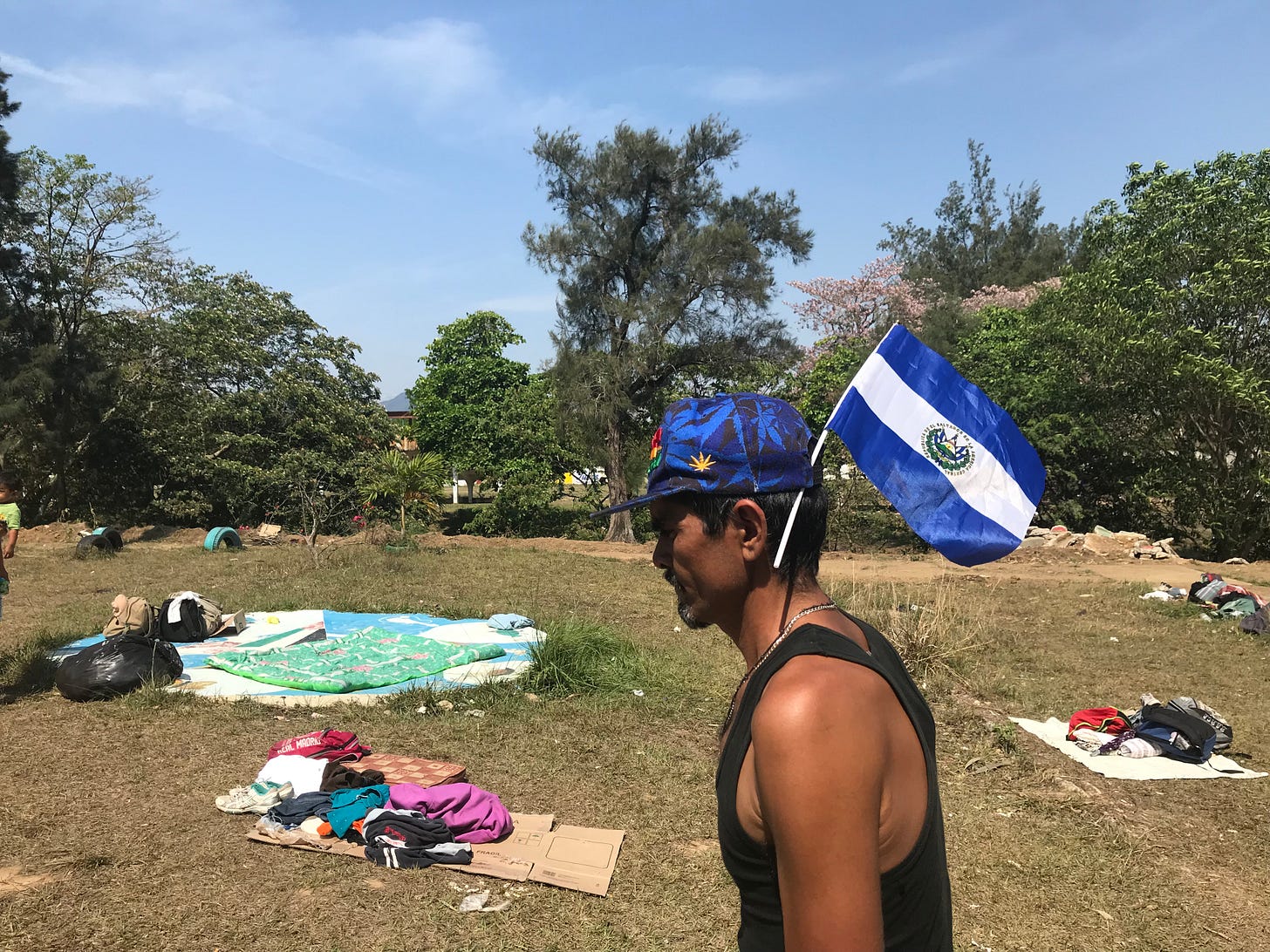
More Mexico immigration detention during Biden administration?
AMLO often advances a discourse of respecting migrants’ rights and offering them opportunities to work in southern Mexico – where wages are low and few migrants wish to toil. He speaks of funding programs rural development and youth employment programs in Central America – and wants the U.S. government to pump in $4 billion – though contacts in the region told this newsletter they’ve never heard of the schemes.
But according to figures from SEDENA recently published by the newspaper Reforma, Mexico has deployed 294% more federal forces to stop transmigration during the first 19 months of the Biden administration that prior to him taking office. Reforma, citing a report circulating in the president’s office, said Mexico had stopped 34,786 migrants at the northern border in 2021, an increase of 97% over 2019. It also stopped 237,277 migrants at the southern border with Guatemala, a 272% jump over 2019 – the year then-president Donald Trump threatened Mexico with escalating tariffs if it didn’t stop transmigration.
The Reforma report followed Defence Secretary Gen. Luis Cresencio Sandoval making a little-noticed reference to a sharp increase in migrant “rescues” – a euphemism for detentions – while giving a long list of army accomplishments during AMLO’s July 20 press conference. Sandoval said the army, navy, National Guard, National Immigration Institute (INE) and various state police forces had increased immigration checkpoints, especially in the Isthmus of Tehuantepec, the skinny belt between the Pacific Ocean and the Gulf of Mexico, which many migrants must traverse on northward journeys.
Sandoval said orders were given June 21 to step up enforcement, but didn’t explain the circumstances – though it proceeded a July 12 meeting between AMLO and Biden. Between June 21 and July 20 some 36,497 migrants were “rescued,” a 79% increase over the 30 days prior to the extra enforcement, Sandoval said.
“This reinforcement will continue in order to achieve these results of rescuing migrants,” Sandoval said, without divulging additional details. He put the number of soldiers working on migration and “development of the northern and southern borders” at 28,807.
GOV’T BLAMES AEROMEXICO FOR AIRPORT WOES; AIRLINE PUSHES BACK
As has become custom for the Mexico’s populist president, AMLO pinned the problems of his administration on private sector actors and other levels of government. On Monday, the head of Mexico’s consumer watchdog PROFECO blamed Aeromexico for the delays at the dilapidated Mexico City International Airport (AICM), alleging Aeromexico’s staff like to “call in sick.” PROFECO boss Ricardo Sheffield said at AMLO’s press conference, “When a flight attendant is missing in the morning they have to wait quite awhile to replace him or her and that has caused a large number of delays.”
Aeromexico countered, saying the airline led its peers in punctuality– to which Sheffield responded via Twitter: “@Aeroméxico ranks first for complaints filed with @Profeco in the area of cancellations and delays.”

A tale of three airports
AMLO blaming Aeromexico follows a flood of complaints over a series of aborted landing and the deteriorating conditions of the ACIM, which is oversaturated was supposed to be replaced by airport to the northeast known as the New Mexico City International Airport (NAICM). The FAA also downgraded Mexico’s safety rating to Category 2 last year, meaning Mexican carriers cannot start new routes to the United States until the Category 1 rating is restored.
But tblaming Aeromexico continues a pattern of AMLO laying the groundwork for transferring traffic to a new airport some 30 miles north of Mexico City – one of the pet projects of his administration, along with a train circling the Yucatán Peninsula – which has attracted scant interest from passengers and airlines alike. The new airport has been so under-utilized that AMLO himself has yet to fly out of it – and it was so quiet on its inauguration day that a woman selling tlayudas made headlines for hawking the oaxaqueno delights in a baggage claim area.
The back story
AMLO canceled the NAICM after calling a snap plebiscite in October 2018, in which barely 1% of registered voters participated. Construction stopped on the NAICM, even though it was roughly one-third complete. AMLO alleged corruption in the construction of a mega-project in a state, where former president Enrique Peña Nieto’s political faction was infamous for combining business with politics. (AMLO’s administration has never lodged criminal complaints.) Bond holders were paid in full, however, with passengers at the AICM paying a ticket tax known as the TUA to pay them off (effectively paying to for an airport which will never be completed.)
The president instead promoted the AIFA, which opened in March, but has barely served any passengers in four months as AICM handles in a day. The AIFA handled 349 flights in June, compared with roughly 1,100 takeoffs and landings daily at the AICM.
AMLO has tried jawboning the airlines to transfer flights to AIFA. He recently said Terminal 2 at the AICM had to be renovated due to structural risks – even though it was constructed in 2007 – requiring a reduction in service. The sorry state of the airport was summed up by a pothole appearing one of the two runways, forcing flight delays – including a flight carrying AMLO.
Now flights are moving little by little to AIFA, which started with connections to only five domestic destinations and service to Venezuela – a country under U.S. sanctions with a regime to which AMLO has lent succour. The sorry state of the AICM feeds suspicions AMLO is allowing the airport to deteriorate to provide a pretext for transferring service to AIFA.
More military management
The Army built the AIFA and a military company operates the facility, along with airports in Tulum, Chetumal and Palenque, Chiapas (home to impressive Maya ruins and where AMLO owns a ranch).
AMLO tapped the Navy this week to operate a pair of airports in Sonora state, serving Guaymas and Ciudad Obregón, “where concessions were not granted in the neoliberal period.” This follows AMLO appointing an admiral to manage the AICM and 1,500 navy personal to provide security in the facility.
The president also improbably claimed on Monday that SEMAR management had so improved the AICM that not not a single suitcase had been lost.



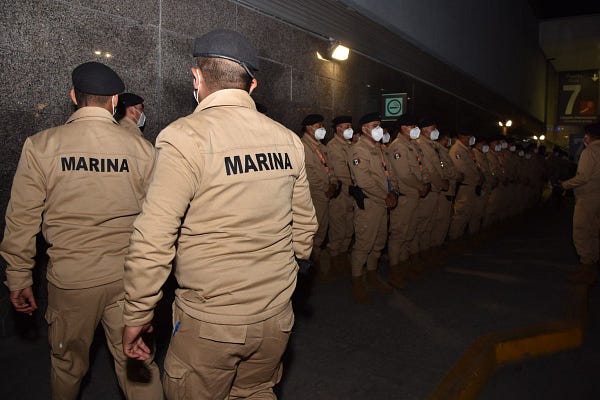

AMLO GETS WHITE GOLD FEVER
On Tuesday, AMLO decreed the creation of a state-run lithium company, which will be christened: Lithium for Mexico (Litio para México) or LitioMx. The company is charged with exploring for, exploiting and commercializing lithium, while excluding the participation of private players. With the decree, “The energy sovereignty of the nation is guaranteed over lithium and other minerals that are strategic and necessary for the energy transition, technological innovation and national development,” according to the Diario Oficial de la Federación.
The push to nationalize lithium advances AMLO’s resource nationalism narrative more than making a serious attempt to cash in on abundant lithium reserves, according to analysts, who question whether Mexico has much lithium producing potential.
A bonanza or fool’s gold?

At present, a Chinese-owned company is developing a lithium project in Sonora state near the Arizona border, which is scheduled to start production in 2023. But experts are skeptical. The Mexican Association of Mining Engineers, Metallurgists and Geologists said in an April statement:
“Clays containing lithium have been located (in Mexico.) … To the best of our knowledge, no country has produced and commercialized lithium from clays.”
The prospect of a lithium boom – spurred by the production of electric vehicles and green energy – has ignited imaginations. Foreign Minister Marcelo Ebrard gushed on Wednesday: “Mexican lithium is key for the production of electric vehicles in Mexico,” while marvelling at California’s plans to ban gasoline vehicle sales after 2035. (No word, however, on the López Obrador administration building a behemoth refinery in Tabasco state.)
Latin America holds some of the world’s most promising reserves, especially in the so-called “lithium triangle” of Argentina, Bolivia and Chile. But extracting those reserves takes time and expertise – and governments, especially in Bolivia, insist on state-participation to their detriment. The Wall Street Journal reported last month:
“In Bolivia, the government nationalized its lithium industry years ago and has yet to produce meaningful amounts of the metal. Mexico, a smaller player, also recently nationalized lithium. In Argentina, output is only starting to take off.
“Here in Chile, where lithium is already tightly controlled, President Gabriel Boric’s new leftist government plans to create a state lithium company after criticizing past privatizations of raw commodities as a mistake.”
The article quoted Benjamin Gedan, a Latin America expert at the Washington-based Woodrow Wilson Center, who observed:
“Latin America specializes in killing golden geese and one of the quickest ways to do so is through resource nationalism.”
AMLO is insisting on resource nationalism, however. The move to nationalize lithium follows the failure to approve a reform, which would have put more of the electricity industry under state control – effectively wiping out clean energy investments, which AMLO opposes and considers a proxy for privatization of the sector. The U.S. and Canadian governments have requested trade dispute talks under the USMCA agreement, alleging Mexico’s actions to curtail clean energy “have largely cut off US and other investment in the country’s clean energy infrastructure,” according to a statement from U.S. trade representative Katherine Tai.
Mexico could be subject to tariffs if no agreement is reached. Lawyers – including Mexico’s own USMCA negotiators – say energy is part of the USMCA and the agreement doesn’t allow favouring state firms over private players. AMLO, however, has dismissed those arguments, saying Wednesday:
“We consider this not to be a technical matter. It’s a political matter. We have a very good economic relationship (with the United States) which is why I’m saying this is a political matter.”
YET ANOTHER JOURNALIST KILLED IN MEXICO
Journalist Fredid Román was shot dead in the city of Chilpancingo – capital of Guerrero state, south of Mexico City – as the misery for Mexican media workers deepens in what has become the most murderous country in the world for media workers outside a war zone. Román was shot dead outside the front door of his home Monday with the assailants escaping on a motorcycle. He was the 15th journalist murdered in Mexico this year – and the second this month, following the death of Juan Arjón López, whose body was discovered in Sonora state.
No motive has been given for Román’s murder, though he wrote critically of all levels of government for La Realidad – an outlet he founded – and other media. He most recently wrote on the government’s report on the Ayotzinapa students, whose college is located near Chilpancingo, saying:
“The revealed conclusions are the result of an investigation undertaken by the previous authorities, at least what Encinas presented as advances in the investigation were the same as what was already known. The only new thing is the interpretation of this tragedy: a state crime.
The Guerrero state prosecutor’s office said in a statement that Román’s son had been murdered two months earlier, though it’s uncertain if the events are linked.


The Committee to Protect Journalists now calls 2022 the most murderous year on record for media workers. Press freedom organization Article 19 released a report finding attacks on the media increased by 51.83% during the first six months of 2022, when compared to the same period in the previous presidential administration. Though parts of Mexico are rife with organized crime violence, Article 19 noted:
“The state continues being since 2007 the main aggressor against the press, perpetrating 128 aggressions (in the first six months of 2022) or the equivalent of 38.67% of the total.
NARCOS SET TORTILLA PRICES

A criminal group in city of Iguala has forced local tortilla mills to reduce prices to 21 pesos per kilo, even though prices have climbed to 30 pesos per kilo in the rest of Guerrero state. Reforma reported posts circulated on social media, in which one of the two gangs disputing the city announced the price cut “to support Iguala families.”
The city – notorious as the site of the 2014 attack on the Ayotzinapa students – is disputed by a pair of criminal groups, which extort monthly payments of 3,000 pesos from 250 local tortillerías, according to Reforma. Tortillas are the most basic of Mexican staples – used to measure inflation and a unit for calculating the purchasing power of the minimum wage.
But th episode offered yet another example of narcos setting prices in states such as Guerrero, where criminal groups extort money at all steps of supply chains – producers, distributors and retailers – causing the closure of markets and staples such as chicken to become unavailable.


Anti-corruption NGO Transparency International released its annual Corruption Perceptions Index and there results are dismal for Latin America – especially Central America with the increasingly tyrannical Sandinista regime in Nicaragua, El Salvador becoming a dictatorship and Guatemala further backsliding after making impressive gains in its anti-graft actions of the mid 2010s.
Mexico stayed stagnant on the index with a score of 31 out of 100 – raking 124 out of 180 countries, same as Niger, Gabon and Papua New Guinea – after improving three points from its nadir of 28 at the end of the Peña Nieto administration in 2018. (The United States scored 67 on the index; Uruguay was tops in Latin America at 73, followed by Chile at 67 and Costa Rica at 58.)
TI said of Mexico:
With a score of 31, Mexico has failed to increase its score on the 2021 CPI. Despite the president’s strong anti-corruption rhetoric, major corruption cases in the country have gone unpunished. The lack of recovered assets and the growing number of scandals involving close associates of the president partly explain Mexico’s result. Furthermore, there has been recent criticism over the political and electoral use of the Attorney General’s Office – which, despite its formal autonomy, is not perceived as independent.
WORTH READING
Today’s exodus is facilitated by Cuba’s close ally Nicaragua, which in November dropped visa requirements for Cubans to fly to the capital Managua. That opened a corridor for Cubans, mostly using “coyotes,” or people smugglers, to make their way overland to the U.S. through Central America and Mexico. The move has eased political and social pressure on the Cuban government as younger Cubans frustrated with conditions abandon the island.

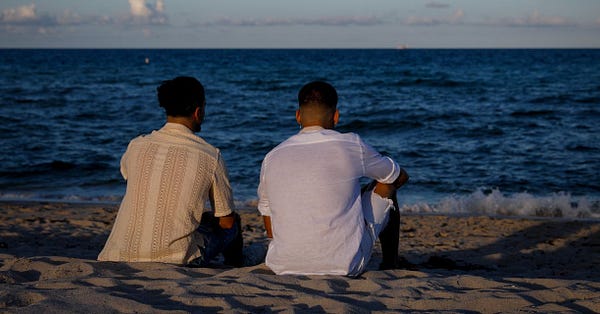
“It was not common for us to help Chinese companies," said Hector Tijerina, executive director at Invest Monterrey, which promotes investment in Nuevo Leon. "But after the tariffs were imposed by the U.S. government to China in 2018, a lot of Chinese companies started to knock on the door.”
In 2016, the mayor Zaragoza, Coahuila, accused the behemoth Constellation Brands brewery just south of the Texas border at Eagle Pass of sucking the towns waterworks dry – taking the water to make beers like Corona and Modelo for export to the United States. Constellation Brands hotly denied the charges, blaming the towns antiquated water infrastructure for its shortages.
But Constellation Brands told this newsletter that it paid to improve that same infrastructure. And it comes as AMLO wonders aloud of banning brewing in the borderlands, even though Mexico ranks as the world’s top exporter of beer, overtaking Holland in 2010. But he raises questions about a business model, which companies like Constellation Brands and Heineken brew exclusively for exports in arid regions currently suffering severe drought.

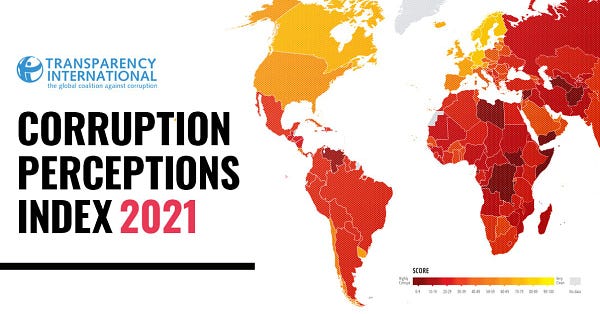
Radio Free Europe has an interesting story on how Kyrgyz migrants are increasingly arriving at the U.S. border after paying travel agencies and smugglers to take them from Central Asia to the United States via Mexico. One woman told the news outlet:
“We flew from [the Russian city of] Sochi to Istanbul, then to Cancun in Mexico, then went to Tijuana and Mexicali," Aisalkyn said. "In Tijuana, [the traffickers] demanded $2,000 per adult and $800 per child to help us cross the [U.S.] border. We tried many times. We tried by foot and twice by car. On our 17th failed attempt, Border Patrol officers seized our vehicle.”




